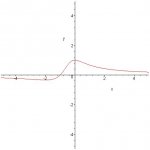rachelshelby10
New member
- Joined
- Apr 12, 2009
- Messages
- 6
The problem says.. given the function f(x)= (x+1) / (x^2+x+1)... find the first order critical numbers.
**I know that you have to find the first derivative first, and I think I have that part right, but after that you are supposed to set it to zero and find the critical numbers, but I am stuck on what to set to zero and how to get those numbers with dividing polynomials.. this is what I have so far: For the derivative i got: f '(x)= (-x^2 + 3x)/(x^2 + x + 1)^2..... After getting the derivative I'm not sure what to do..... Do I factor first polynomial and set it to zero and solve and do the same with the denominator polynomial ?.....I can solve these problems if it is just one constant polynomial, but I do not like fractions......I'm stuck! If anyone can help me it will be greatly appreciated! Thank you in advance!
If anyone can help me it will be greatly appreciated! Thank you in advance!
**I know that you have to find the first derivative first, and I think I have that part right, but after that you are supposed to set it to zero and find the critical numbers, but I am stuck on what to set to zero and how to get those numbers with dividing polynomials.. this is what I have so far: For the derivative i got: f '(x)= (-x^2 + 3x)/(x^2 + x + 1)^2..... After getting the derivative I'm not sure what to do..... Do I factor first polynomial and set it to zero and solve and do the same with the denominator polynomial ?.....I can solve these problems if it is just one constant polynomial, but I do not like fractions......I'm stuck!

